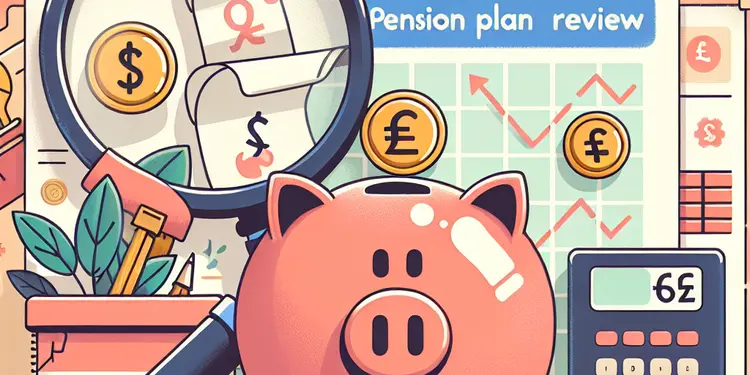Find Help
More Items From Ergsy search
-

Student Finance: Should I pay more? | Plan 1 & Plan 2 | SF Explained
Relevance: 100%
-

What is the role of independent financial advisors in pension planning?
Relevance: 66%
-

Planning for your funeral
Relevance: 59%
-

Can a robo-advisor help with pension planning?
Relevance: 55%
-

What is an asthma action plan?
Relevance: 54%
-

Planned caesarean section
Relevance: 54%
-

How often should I review my pension plan?
Relevance: 53%
-

Can funeral directors offer payment plans?
Relevance: 53%
-

How can I plan for future care needs?
Relevance: 51%
-

Do water companies have long-term infrastructure plans?
Relevance: 50%
-

Having a planned caesarean section
Relevance: 50%
-

Are there implications for student loan repayments with 2026 changes?
Relevance: 50%
-

Wills, Probate and Tax Planning in the UK
Relevance: 49%
-

How will the changes in pension age affect retirement planning?
Relevance: 48%
-

Could my payment plan affect how overpayments are handled?
Relevance: 47%
-

Planning Your Funeral in Advance? | Expert Tips from Celebrants
Relevance: 47%
-

Do insurance plans cover the cost of self-testing tools?
Relevance: 47%
-

What is an Education, Health and Care Plan (EHCP)?
Relevance: 46%
-

What is the new planned state pension age after 2028?
Relevance: 46%
-

Pre operative Information for Planned Caesarean Birth
Relevance: 45%
-

The NHS Long Term Plan for learning disability and autism
Relevance: 45%
-

What funding options are available for nursing students in the UK?
Relevance: 43%
-

How does the payment affect students' financial aid packages?
Relevance: 43%
-

The Different Roles in Sexual Health and Family Planning UK
Relevance: 43%
-

How can I plan efficiently to mitigate inheritance tax?
Relevance: 42%
-

Are there any planned changes to tax bands for April 2026?
Relevance: 41%
-

Can students apply for Cost-of-Living support?
Relevance: 41%
-

NHS Winter Preparedness Plans Unveiled Amid Rising Seasonal Pressures
Relevance: 41%
-

Is there a plan to offer additional support to offset housing benefit cuts?
Relevance: 41%
-

Chancellor Unveils Plans to Reform UK Tax System
Relevance: 40%
-

Are there financial aids available for further education?
Relevance: 40%
-

Can mature students apply for the £500 cost of living payment?
Relevance: 39%
-

Harshi’s learning disability annual health check and health action plan
Relevance: 39%
-

Can part-time students apply for the £500 payment?
Relevance: 39%
-

UNDERSTANDING YOUR STUDENT LOAN: A GUIDE FOR ENGLISH STUDENTS STARTING AN UNDERGRADUATE COURSE 2023
Relevance: 39%
-

Are students required to pay for a TV license?
Relevance: 38%
-

Can students receive the £500 cost of living payment?
Relevance: 38%
-

Is there an income threshold for students to qualify for the payment?
Relevance: 38%
-

Will students receive the payment directly into their bank accounts?
Relevance: 38%
-

Do international students qualify for the £500 payment?
Relevance: 37%
Student Finance: Should I Pay More? | Plan 1 & Plan 2 | SF Explained
Introduction
Student finance can be a complex topic, especially when you are trying to understand the repayment plans and how much you should be paying back. This guide focuses on providing clarity for UK students under Plan 1 and Plan 2 repayment schemes, ensuring you are well-informed about your financial obligations and making the right decisions.
Understanding Plan 1 & Plan 2
In the UK, student loans are primarily categorized under two plans - Plan 1 and Plan 2. These plans determine your repayment terms based on when and where you studied.
- Plan 1: Applicable to students who started their undergraduate course in the UK before September 2012. It also applies to students from Scotland and Northern Ireland.
- Plan 2: For students who began their undergraduate courses in England and Wales from September 2012 onwards.
Key Differences Between Plan 1 & Plan 2
The critical differences between Plan 1 and Plan 2 lie in the repayment thresholds and interest rates. For instance, the repayment threshold for Plan 1 is typically lower than that of Plan 2. As of the current academic year, borrowers start repaying their Plan 1 loans once their annual income exceeds £20,195. Meanwhile, for Plan 2, the threshold is higher, with borrowers only starting to repay once their income surpasses £27,295.
Should I Pay More? & Early Repayment
One common question students might ask is whether they should pay more than the minimum required amount. There are a few factors to consider when making this decision:
- Interest Rate: Loans accumulate interest over time. For Plan 1, the interest rate is either the Retail Price Index (RPI) or the Bank of England base rate plus 1%, whichever is lower. Plan 2 loans accrue interest at RPI plus up to 3%, depending on your income.
- Circumstances: If you anticipate a significant increase in your earnings or aim to reduce your overall debt burden, making extra payments could be beneficial.
- Loan Forgiveness: Both Plan 1 and Plan 2 loans have a forgiveness clause, where any remaining debt is written off after 30 years (Plan 2) or 25 years (Plan 1) or when you turn 65.
Conclusion
Understanding the specifics of your student loan repayment plan can have a significant impact on your financial future. While it might seem daunting initially, knowing the key points of Plan 1 and Plan 2, and considering whether making extra payments suits your situation, will help you manage your student loan more effectively. Always assess your individual circumstances and seek financial advice if needed to make the best decision for your situation.
Student Finance: Should I Pay More? | Plan 1 & Plan 2 | SF Explained
Introduction
Understanding student finance can be tricky. This guide is here to help UK students learn about Plan 1 and Plan 2 for student loans. We will talk about how much you might need to pay back and help you make smart choices about your money.
Understanding Plan 1 & Plan 2
In the UK, student loans have two main types: Plan 1 and Plan 2. These decide when and how much you start paying back depending on when and where you studied.
- Plan 1: If you started your course in the UK before September 2012, or if you are from Scotland or Northern Ireland, this plan is for you.
- Plan 2: If you started your course in England and Wales from September 2012 onwards, this is your plan.
Key Differences Between Plan 1 & Plan 2
The big differences between Plan 1 and Plan 2 are in the repayment amount and interest. For Plan 1, you start paying back when you earn more than £20,195 a year. For Plan 2, you start paying when you earn over £27,295 a year.
Should I Pay More? & Early Repayment
Some students wonder if they should pay more than the required amount. Here are some things to think about:
- Interest Rate: Loans get bigger because of interest. Plan 1 adds interest using a lower rate. Plan 2 adds RPI plus up to 3% interest, depending on your income.
- Circumstances: If you expect to make more money or want to pay less overall, paying extra might be good.
- Loan Forgiveness: Your loan may be canceled after 30 years (Plan 2) or 25 years (Plan 1), or when you turn 65, if not fully paid.
Conclusion
Knowing your student loan plan helps with future money decisions. It might seem hard at first, but understanding Plans 1 and 2 will help you manage your loan better. Think about your situation, and if needed, get financial advice to make smart decisions.
Frequently Asked Questions
What is Plan 1 for student loan repayment?
Plan 1 is a student loan repayment plan for undergraduates who started their course before 1 September 2012 in England or Wales, or before 1 September 1998 in Scotland or Northern Ireland.
What is Plan 2 for student loan repayment?
Plan 2 is a student loan repayment plan for undergraduates who started their course on or after 1 September 2012 in England or Wales.
When do I start repaying my student loan under Plan 1?
You start repaying your loan under Plan 1 in the April after you leave your course, but only if your income is over the repayment threshold.
When do I start repaying my student loan under Plan 2?
You start repaying your loan under Plan 2 in the April after you leave your course, but only if your income is over the repayment threshold.
What is the current repayment threshold for Plan 1?
For Plan 1, the repayment threshold is currently £20,195 a year.
What is the current repayment threshold for Plan 2?
For Plan 2, the repayment threshold is currently £27,295 a year.
How much do I repay under Plan 1?
Under Plan 1, you repay 9% of your income over the repayment threshold.
How much do I repay under Plan 2?
Under Plan 2, you repay 9% of your income over the repayment threshold.
What happens if my income drops below the repayment threshold?
If your income drops below the repayment threshold, your repayments will stop until your income goes above the threshold again.
Can I make extra repayments on my student loan?
Yes, you can make extra repayments on your student loan at any time without incurring penalties.
How is the interest rate on my student loan calculated under Plan 1?
Under Plan 1, the interest rate is either the retail price index (RPI) or the Bank of England base rate plus 1%, whichever is lower.
How is the interest rate on my student loan calculated under Plan 2?
Under Plan 2, the interest rate is based on RPI and ranges from RPI only to RPI plus 3% depending on your income.
What happens if I move abroad?
If you move abroad, you still have to repay your student loan. You need to inform the Student Loans Company and your repayment amount will be adjusted based on the cost of living in the country you move to.
Will my student loan be written off at any point?
Yes, for Plan 1 loans, any remaining balance is written off 25 years after the April you were first due to repay or when you turn 65, whichever comes first. For Plan 2 loans, any remaining balance is written off 30 years after the April you were first due to repay.
How do repayments work through PAYE?
If you're employed, your repayments are automatically deducted from your salary through the PAYE system by your employer.
What is Plan 1 for paying back student loans?
If you borrowed money as a student, you will have to pay it back. This is called a student loan.
Plan 1 is a way to pay back your student loan. It tells you how much you need to pay and when you need to start paying.
Here are some tips to help you:
- Use a calculator to see how much you need to pay back every month.
- Set up reminders to pay on time.
- Ask a friend or family member if you have questions.
Plan 1 is a way to pay back student loans. It is for students in college.
This plan is for students who started college:
- Before 1 September 2012 in England or Wales.
- Before 1 September 1998 in Scotland or Northern Ireland.
If you have trouble reading, try using tools like a text-to-speech app to read it out loud. You can also ask someone to help you understand the information.
What is Plan 2 for paying back a student loan?
Plan 2 is a way to pay back money you borrowed for school or college. It helps you pay back your student loan.
If you have a Plan 2 loan, you start paying back when you earn enough money.
Using a calculator can help you see how much you need to pay. You can also ask someone to help you understand your payments.
Plan 2 is a way to pay back student loans. It is for students who started their university course on or after 1 September 2012 in England or Wales.
Helpful Tip: Use tools like audiobooks or text-to-speech to listen to information if reading is hard. You can also use highlighter pens to mark key points.
When do I pay back my Plan 1 student loan?
You start paying back your loan after you leave your course. This happens in April.
You only pay if you make more money than a certain amount.
When do I start paying back my Plan 2 student loan?
You start paying back your loan after your course ends. This happens in April. But you only pay if you earn more than a set amount of money.
How much money do you have to earn before paying back Plan 1?
For Plan 1, you pay back your loan when you earn more than £20,195 a year.
How much money do you need to earn before you start paying back a Plan 2 loan?
For Plan 2, you start paying back your loan when you earn more than £27,295 each year.
How much do I pay back with Plan 1?
You pay back some of your loan when you earn money.
Use a calculator to help find out how much you pay back.
Ask someone you trust to help you understand.
With Plan 1, you pay back 9% of the money you earn after you make a certain amount.
What do I pay back with Plan 2?
With Plan 2, you pay back 9% of the money you earn over a certain amount.
What if I earn less money than the amount needed to start paying back?
If you earn less money and it goes below a certain amount, you don't have to make payments. You will stop paying until you earn more money again.
Can I pay extra money on my student loan?
Yes, you can pay more money on your student loan whenever you want. This might help you pay it off faster.
Here are some tips:
- Make a plan: Decide how much extra you can pay each month.
- Ask for help: Talk to your bank or loan company. They can explain how to make extra payments.
- Use a calculator: Online tools can show you how extra payments change your loan.
You can pay extra money on your student loan whenever you want. You will not get in trouble for doing this.
How do they work out the interest rate on my student loan for Plan 1?
This means: How do they decide how much extra money I pay on my student loan for Plan 1?
Here is a simple way to understand:
- The interest rate is a small extra amount added to what you owe.
- On Plan 1, they use different things to work out the interest rate.
- They look at things like how much money you make.
Need help with this? You could:
- Ask someone you trust to explain it.
- Use online tools or apps that read aloud to you.
With Plan 1, the interest rate is the lower one between two choices:
- The retail price index (RPI).
- Or the Bank of England base rate plus 1%.
If you find it tricky to understand, you can use tools like a calculator or ask someone you trust to help you.
How do they work out the interest on my student loan for Plan 2?
If you have Plan 2, the way interest is worked out depends on how much money you make. It starts with RPI, which is a big word for how much prices go up. Then, depending on what you earn, it can go from just RPI to RPI plus a bit more, up to 3%.
To help understand your plan better, you might use pictures or ask someone you trust to explain it with you. Talking it through can make it clearer!
What happens if I move to another country?
If you go to live in a different country, some things might change.
Here are some things to think about:
- You might need new papers, like a passport or a visa, to live there.
- You may have to tell the government where you are going.
- Your money might be different. You might need to change it to their money.
- If you are on medicine or need a doctor, check how to get help there.
- You might have to learn some new words from their language.
To help with this:
- Ask an adult or a helper if you need more information.
- Use a map to see where the new country is.
- Practice the new language a little before you go.
If you move to a different country, you still need to pay back your student loan. Tell the Student Loans Company when you move. The amount you pay back will change depending on how much it costs to live in the new country.
To make it easier, you can use a calendar to remember your payment dates, and try using a budget app to help manage your money.
Will my student loan be canceled one day?
A student loan is money you borrow to pay for school. Sometimes, you might not have to pay back all the money you borrowed. This can happen after a long time.
Here are some tools and tips to help you understand:
- Use a calendar to see how much time has passed.
- Ask someone you trust for help with money questions.
- There are online tools that can tell you when your loan might be canceled.
If you have a Plan 1 loan, your loan can be canceled after 25 years. This starts from the April when you had to start paying it back. It can also be canceled when you turn 65, whichever is sooner.
If you have a Plan 2 loan, your loan can be canceled after 30 years. This starts from the April when you had to start paying it back.
Here are some tips to help understand loans better: - Use a calculator to keep track of how much you owe. - Ask an adult for help if you have questions. - Read about loans on a website that explains it simply. - Watch videos for a clear explanation.How do repayments work through PAYE?
PAYE means "Pay As You Earn." It is a way to pay back money you owe, like a loan.
Here is how it works:
- When you earn money from your job, a small part is taken out.
- This money is used to pay back what you owe.
- The more you earn, the more you pay back.
- If you earn less, you pay back less.
Tools that can help:
- A calculator to see how much will come out of your pay.
- Talk to someone if you are not sure what to do.
If you have a job, your boss will take the repayments from your pay automatically. This is done through a system called PAYE.
Useful Links
- Ergsy carfully checks the information in the videos we provide here.
- Videos shown by Youtube after a video has completed, have NOT been reviewed by ERGSY.
- To view, click the arrow in centre of video.
- Most of the videos you find here will have subtitles and/or closed captions available.
- You may need to turn these on, and choose your preferred language.
- Go to the video you'd like to watch.
- If closed captions (CC) are available, settings will be visible on the bottom right of the video player.
- To turn on Captions, click settings .
- To turn off Captions, click settings again.
More Items From Ergsy search
-

Student Finance: Should I pay more? | Plan 1 & Plan 2 | SF Explained
Relevance: 100%
-

What is the role of independent financial advisors in pension planning?
Relevance: 66%
-

Planning for your funeral
Relevance: 59%
-

Can a robo-advisor help with pension planning?
Relevance: 55%
-

What is an asthma action plan?
Relevance: 54%
-

Planned caesarean section
Relevance: 54%
-

How often should I review my pension plan?
Relevance: 53%
-

Can funeral directors offer payment plans?
Relevance: 53%
-

How can I plan for future care needs?
Relevance: 51%
-

Do water companies have long-term infrastructure plans?
Relevance: 50%
-

Having a planned caesarean section
Relevance: 50%
-

Are there implications for student loan repayments with 2026 changes?
Relevance: 50%
-

Wills, Probate and Tax Planning in the UK
Relevance: 49%
-

How will the changes in pension age affect retirement planning?
Relevance: 48%
-

Could my payment plan affect how overpayments are handled?
Relevance: 47%
-

Planning Your Funeral in Advance? | Expert Tips from Celebrants
Relevance: 47%
-

Do insurance plans cover the cost of self-testing tools?
Relevance: 47%
-

What is an Education, Health and Care Plan (EHCP)?
Relevance: 46%
-

What is the new planned state pension age after 2028?
Relevance: 46%
-

Pre operative Information for Planned Caesarean Birth
Relevance: 45%
-

The NHS Long Term Plan for learning disability and autism
Relevance: 45%
-

What funding options are available for nursing students in the UK?
Relevance: 43%
-

How does the payment affect students' financial aid packages?
Relevance: 43%
-

The Different Roles in Sexual Health and Family Planning UK
Relevance: 43%
-

How can I plan efficiently to mitigate inheritance tax?
Relevance: 42%
-

Are there any planned changes to tax bands for April 2026?
Relevance: 41%
-

Can students apply for Cost-of-Living support?
Relevance: 41%
-

NHS Winter Preparedness Plans Unveiled Amid Rising Seasonal Pressures
Relevance: 41%
-

Is there a plan to offer additional support to offset housing benefit cuts?
Relevance: 41%
-

Chancellor Unveils Plans to Reform UK Tax System
Relevance: 40%
-

Are there financial aids available for further education?
Relevance: 40%
-

Can mature students apply for the £500 cost of living payment?
Relevance: 39%
-

Harshi’s learning disability annual health check and health action plan
Relevance: 39%
-

Can part-time students apply for the £500 payment?
Relevance: 39%
-

UNDERSTANDING YOUR STUDENT LOAN: A GUIDE FOR ENGLISH STUDENTS STARTING AN UNDERGRADUATE COURSE 2023
Relevance: 39%
-

Are students required to pay for a TV license?
Relevance: 38%
-

Can students receive the £500 cost of living payment?
Relevance: 38%
-

Is there an income threshold for students to qualify for the payment?
Relevance: 38%
-

Will students receive the payment directly into their bank accounts?
Relevance: 38%
-

Do international students qualify for the £500 payment?
Relevance: 37%


